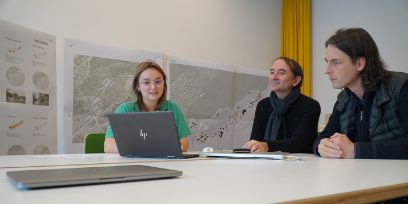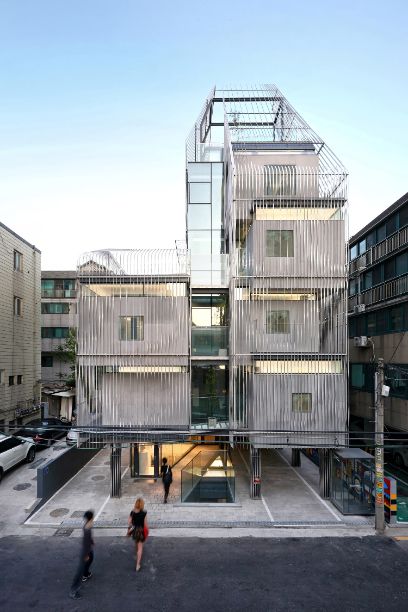- Story
Researching new housing
15.12.2022 Every person in Switzerland requires 46 square metres for living, a figure which is four times lower in Asia. But space-saving and eco-friendly housing options are also becoming increasingly popular here. Céline Zufferey, architecture student at Bern University of Applied Sciences BFH, is taking on this topic and intends to combine two current trends in her master’s thesis.

Céline Zufferey had a moving childhood – in the truest sense of the word: she was born in Switzerland, moved to Canada with her family for four years at the age of one and then moved back to Switzerland for five years. The family then returned to Canada for four years before moving to Australia. Now 25 years old, Céline Zufferey has been back in Switzerland since 2020. Because her father, originally an electrical engineer, was employed as a project manager with an international company, the family lived all over the world, something she recalls as being difficult at times. ‘I had to leave a lot of friends behind and integrate all over again in new groups of young people. That took a lot of energy.’
Communal living in a small space
Growing up on the move, Céline Zufferey also got to know different types of housing. In Australia and Canada, where people have plenty of space to live, she lived in extremely spacious homes, ‘with rooms whose sole purpose was to receive visitors.’ Meanwhile, at college in Australia, she lived in a small room with a shared kitchen in a student dormitory. She also currently lives in a shared flat in Biel. ‘To be honest, I don’t feel too comfortable in communal living spaces,’ says the architecture student. ‘I therefore chose the topic of communal living in a small space for my master’s thesis – also because I want to develop my own personal approach to the subject.’
Housing in Switzerland: responsible for more than one-quarter of the environmental impact
The topic reflects a current trend. Or better put, two trends: small-scale and shared housing. Both are based on concern for the environment, as building and housing have a significant impact in this regard. The average Swiss apartment is around 100 square metres, often joined by a cellar, screed, garden or balcony. According to the Federal Statistical Office (BfS), the average Swiss citizen has an impressive 46 square metres of living space. In 1980, this figure was 36 square metres. Overall, housing is responsible for more than one-quarter of the total environmental impact in Switzerland. A study by the Federal Office for the Environment showed that the larger the living space, the higher the related emissions.
We are therefore better off living on a smaller scale. Shared apartments which house multiple families are one way to do this. While every family has a small retreat and sleeping area in these homes, the kitchen and living room are shared. Examples of this type of living can be found in Zurich’s Hunziker Areal and Kalkbreite Areal cooperative homes, or in the Warmbächli cooperative in Bern. Small-scale housing, i.e. living units with a maximum total area of 40 square metres, is another option. Unlike conventional properties, these living units are not based on solid foundations, but rather on wheels or pad foundations, allowing them to simply be moved. The most common form is the tiny house, a small house usually visually resembling a modern or traditional house and offering no more than 25 square metres of space.
An alternative lifestyle
These alternative forms of living require less space and enable consolidated construction. Often, the buildings are also made of sustainable raw materials such as wood and obtain energy from renewable sources. ‘However, these forms of living also represent an alternative lifestyle,’ says Stanislas Zimmermann, Professor for Architecture and Design at BFH and Head of Degree Programme in the Architecture master’s programme. ‘In most cases, you live close to nature, pay less rent and are free from a lot of material things, opening up new freedoms for people.’ Alongside his work at BFH, Stanislas Zimmermann also runs his own architectural office in Zurich with his partner, where he specialises in building with wood and other natural materials, among other things. He says that despite all the praise they garner, alternative forms of living are also met with criticism: for example, tiny houses could encourage further overdevelopment of the landscape if they start sprouting up all over the place like mushrooms. And while shared forms of living reduce space requirement per person, this still lies at over 30 square metres.
Asia as a role model
So why not combine the two forms of living? Asian countries such as Japan and South Korea are role models in this regard, with living space requirements per person already four times lower than in Switzerland today. One example can be seen in the Songpa micro-housing development in the South Korean capital of Seoul. It contains 14 stacked living units, each with an area of 11 square metres, which can be used as private bedrooms, studies and common rooms. This is the point where the interests of Céline Zufferey and Stanislas Zimmermann converge. Together with Tobias Baitsch, head of the Architecture division at BFH, the latter is supporting the architecture student with her master’s thesis.
The first step is to study the theoretical principles of these alternative forms of living. By summer 2023, Céline Zufferey will then have developed a specific construction project for the Gurzelen Areal in Biel. ‘In Switzerland, we need more variety in construction going forward, as the needs of the population also vary,’ she says. The times when everyone wanted to live in classic 3.5- and 4.5-room apartments are long gone. ‘Sustainability is a major concern for BFH,’ adds Stanislas Zimmermann. ‘This is why it’s important to research alternative forms of living and to find out which are possible here, and which aren’t.’
